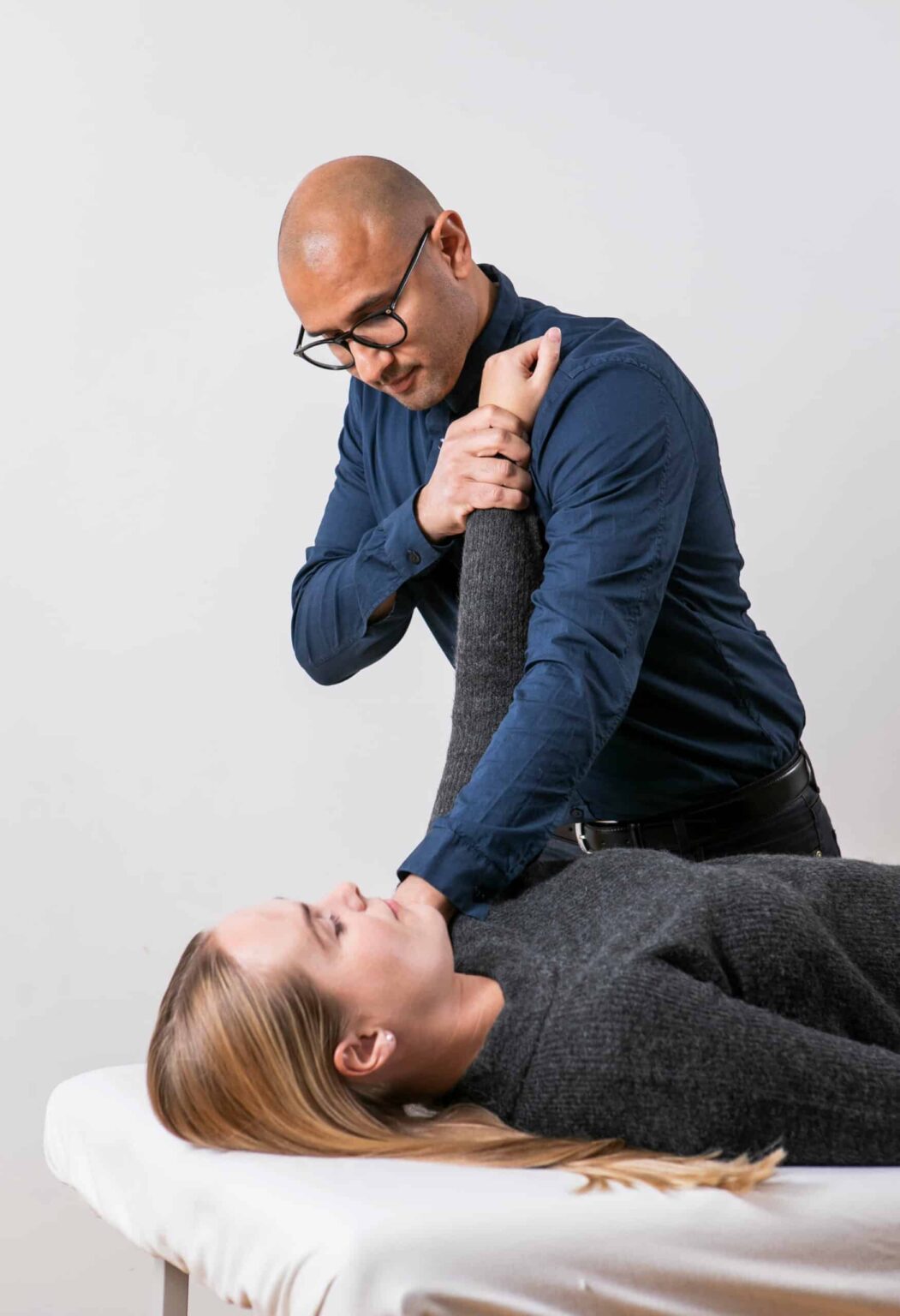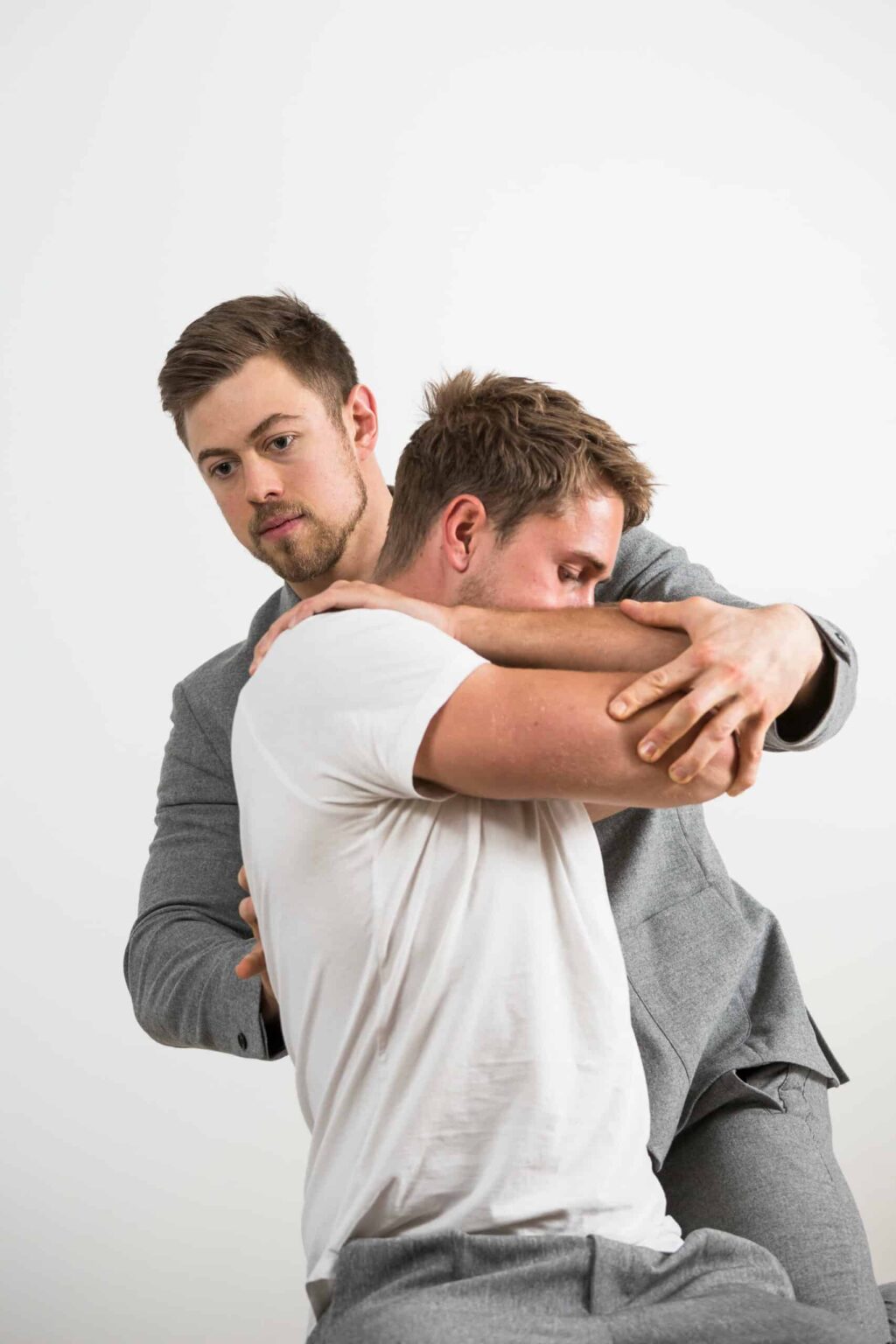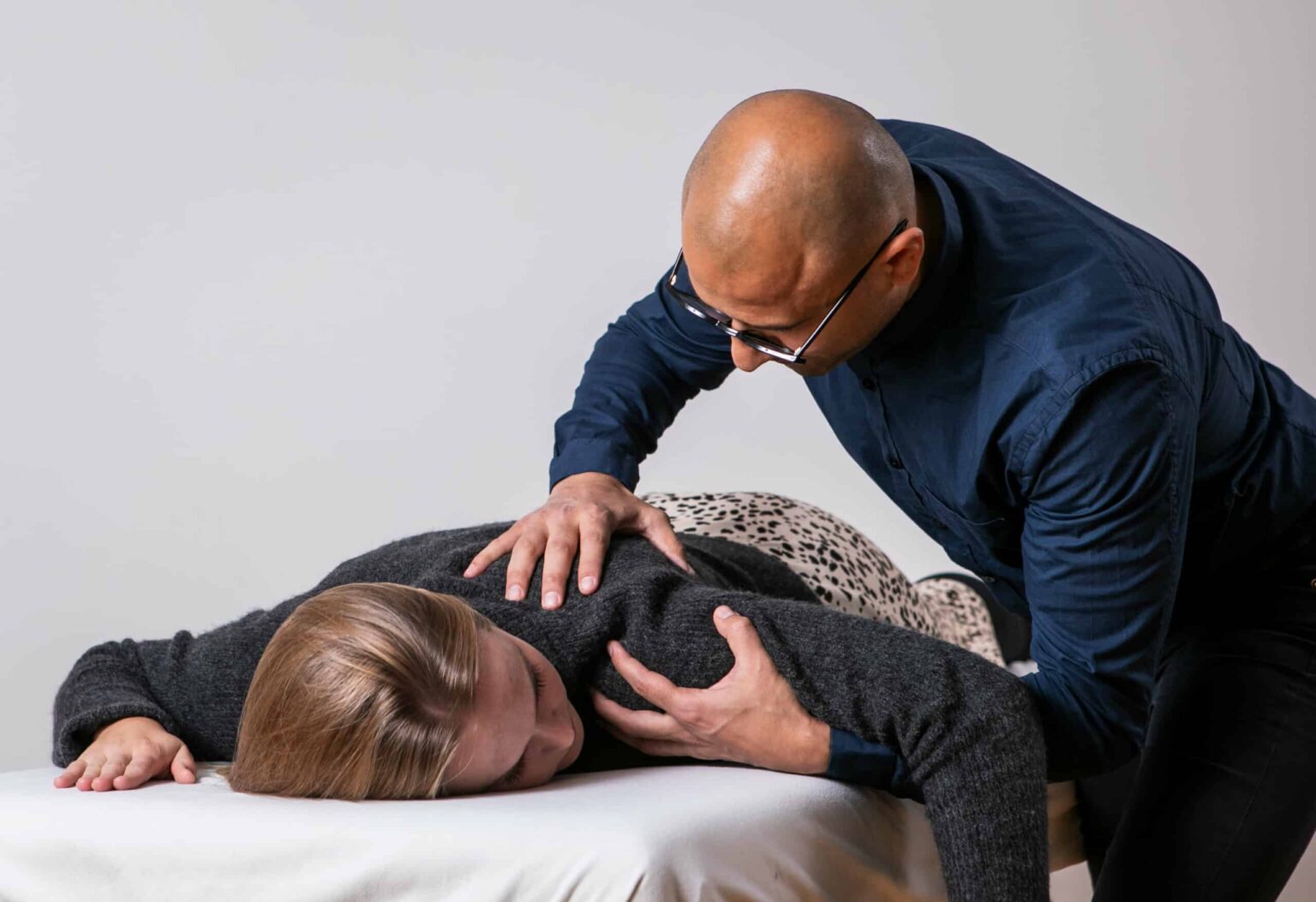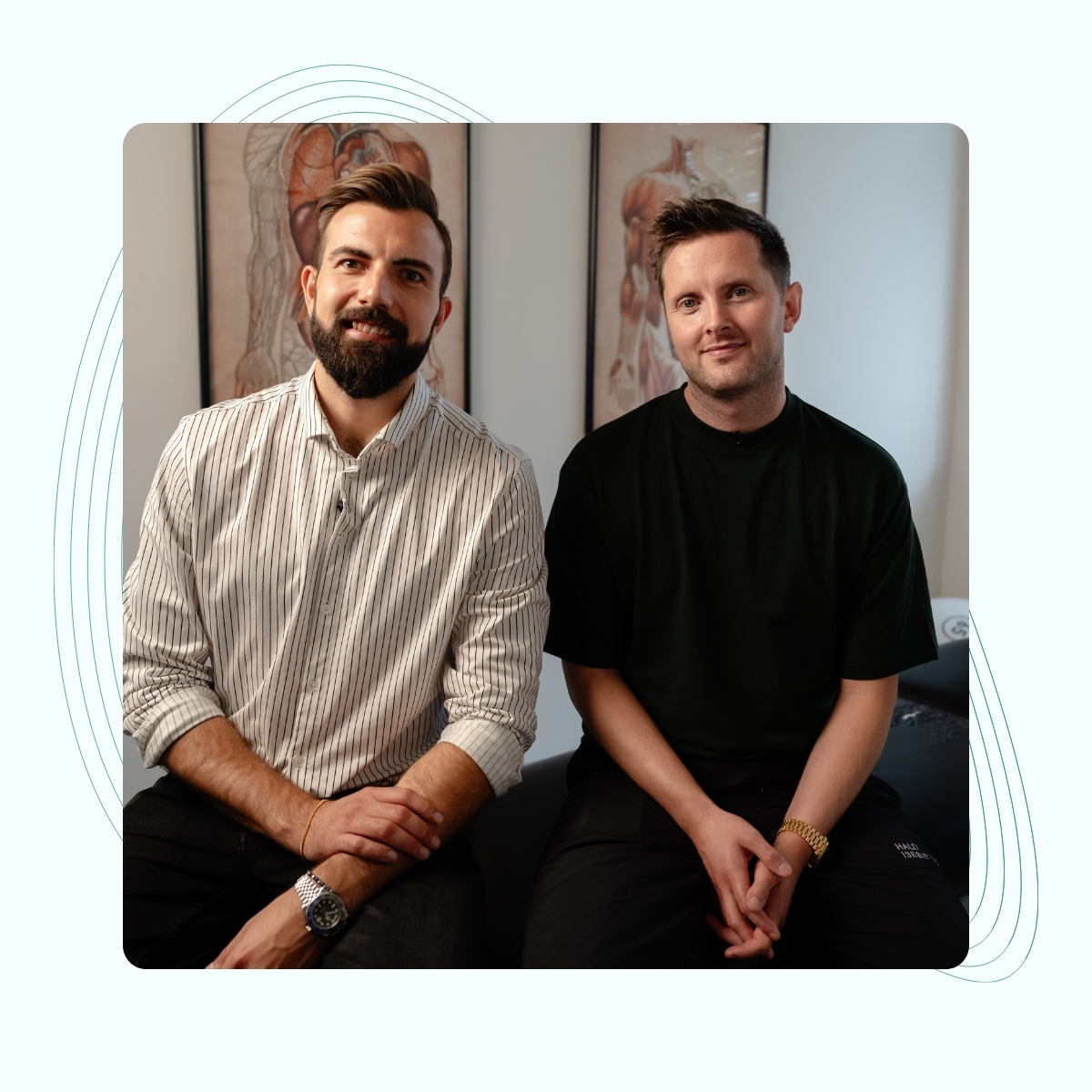We treat
Shoulder pain
Learn more about shoulder pain and its complications
The shoulder is a complex unit
The shoulder joint consists of three joints and one articulation, which requires extreme coordination of all factors that stabilize the joint. This makes the shoulder joint one of the most complex joints in the body. Its high mobility and poor stability make the shoulder prone to pain and injury in daily life and during sports.
Jump to section [Vis]
Shoulder pain – pain in the shoulder
Shoulder pain is, after back and neck pain, the most common musculoskeletal disorder. It is the most mobile joint in the body and at the same time the joint that most frequently dislocates. Shoulder pain can affect the use of the entire arm, adequate work capacity and increase the risk of depression, anxiety and sleep problems.
What is shoulder pain?
The shoulder is the joint between the upper arm bone and the shoulder blade. Pain in and around the head of the upper arm bone and the shoulder blade is called shoulder pain. According to the recognized pain research organization, the International Association for the Study of Pain, pain is defined as: “An unpleasant sensory and emotional experience associated with actual or potential tissue damage, or described in terms of such damage”. The amount of damage or danger is therefore not directly related to the experience of pain, which is always subjective and is influenced by thoughts and emotions, among other things.
Sources: Sundhed.dk, Dodson CC, Cordasco FA. Anterior glenohumeral joint dislocations. Orthop Clin North Am. 2008, Cho CH, Jung SW, Park JY, Song KS, Yu KI. Is shoulder pain for three months or longer correlated with depression, anxiety, and sleep disturbance? J Shoulder Elbow Surg. 2013 and Iasp-pain.org
Symptoms of shoulder pain
- Pain in or around the shoulder and possibly down the arm.
- Stiffness and reduced mobility.
- Weakness – problems lifting heavy things or performing activities of daily living.
- Numbness/tingling in the shoulder and/or arm.
- Clicking sensation when moving the shoulder.
- Feeling of looseness.
- Sleep problems – trouble sleeping on your side.
- Headache – compensatory muscle tension can cause headaches due to shoulder pain.

Causes of shoulder pain
Pain is a calculation made by the brain, based on the signals it receives – including irritations and injuries to the shoulder. As previously mentioned, there is no direct correlation between the amount of damage and the amount of pain, and therefore there are more factors than the injury alone that affect pain.
The cause of shoulder pain can generally be divided into: Which structure sends danger signals that are ultimately perceived as pain? And what is the reason that this structure sends danger signals?
Regarding point 1: The most common trigger structure for shoulder pain is one or more of the four rotating and stabilizing muscles and tendons in the shoulder, called the “rotator cuff”. This can lead to shoulder impingement, inflamed bursa in the shoulder and rotator cuff tendinopathy. In addition, herniated discs in the neck, facet joint syndrome, frozen shoulder, and in rare cases; problems in the liver, gallbladder and pancreas, can cause shoulder pain.
Regarding point 2: What is the reason that this structure sends danger signals? What causes shoulder pain? It can also be caused by several things: Overloading of structures in or around the shoulder, reduced blood supply, nerve compression, lifestyle, thoughts, emotions, beliefs and mental stress.
Sources: Raja SN, Carr DB, Cohen M, Finnerup NB, Flor H, Gibson S, et al. The revised International Association for the Study of Pain definition of pain: concepts, challenges, and compromises. Pain. 2020, Chila A. Foundations of Osteopathic Medicine. 3rd edition ed: Lippincott Williams & Wilkins; 2011, Cools AM, Johansson FR, Borms D, Maenhout A. Prevention of shoulder injuries in overhead athletes: a science-based approach. Braz J Phys Ther. 2015, Mills SEE, Nicolson KP, Smith BH. Chronic pain: a review of its epidemiology and associated factors in population-based studies. Br J Anaesth. 2019 and Mann JB, Bryant KR, Johnstone B, Ivey PA, Sayers SP. Effect of Physical and Academic Stress on Illness and Injury in Division 1 College Football Players. J Strength Cond Res. 2016
Different types of shoulder pain
- Sharp: May be caused by a strain in one or more muscles, the labrum, inflamed bursa, shoulder impingement or irritation of a nerve.
- Jolting: Can be caused by pinching of a nerve, e.g. due to a herniated disc in the neck.
- Burning: May be caused by irritation of one or more tendons in the rotator cuff, frozen shoulder, or pinched nerve.
- Radiant: May be caused by shoulder impingement, frozen shoulder, irritation of one or more nerves, e.g. thoracic outlet syndrome.
- Tingling/numbness: May be caused by irritation of one or more nerves, e.g. herniated disc in the neck.
Source: Rulten T. Case History Taking For Osteopaths – With a touch of Differential Diagnosis 2022

Shoulder pain radiating into the arm
It is not uncommon for shoulder pain to also radiate into the arm and sometimes down to the hand. The cause of the radiation may be due to “neuropathic” or “referred” pain. “Neuropathic” means that there is an injury or disease in one or more nerves that register, among other things, pressure and touch. If there is pressure or compression of such a nerve, for example due to a herniated disc in the neck, it can cause pain in the shoulder and arm and tingling in the fingers. “Referred pain” is pain that is felt in a place other than where the painful structure is located. These structures can be the bursa of the joint, joint capsule, muscles in the shoulder or neck, and in rare cases; the liver, gallbladder, heart, lungs and pancreas.
Sources: Chila A. Foundations of Osteopathic Medicine. 3rd edition ed: Lippincott Williams & Wilkins; 2011, Murnion BP. Neuropathic pain: current definition and review of drug treatment. Aust Prescr. 2018 and Murray GM. Guest Editorial: referred pain. J Appl Oral Sci. 2009
Shoulder pain and cancer
Shoulder pain can be caused by cancer, but fortunately it is rare. In addition to the pain in the shoulders, symptoms can include unexplained weight loss, constant and severe pain and fatigue. Osteopathy cannot cure cancer, but we are trained to know our limitations and refer you to your doctor if necessary.
Sources: sundhed.dk and Koo MM, Swann R, McPhail S, Abel GA, Elliss-Brookes L, Rubin GP, et al. Presenting symptoms of cancer and stage at diagnosis: evidence from a cross-sectional, population-based study. Lancet Oncol. 2020

Inflammation of the shoulder
Inflammation of the shoulder can cause pain, stiffness and limited mobility. The cause may be that you have been exposed to trauma to the shoulder, an acute injury, overuse or osteoarthritis. A common cause of inflammation of the shoulder is bursitis. Bursitis is inflammation of a bursa, and a bursa that is frequently affected by inflammation is called the “subacromial bursa”, which means “bursa that lies under the acromion”, which is a bone part of the shoulder blade that sits on the outside of the shoulder.
What does shoulder inflammation feel like?
The symptoms will typically be pain and tenderness in the affected area, and there may also be redness, warmth and swelling.
What do you do about an inflamed bursa in the shoulder?
The treatment of an inflamed bursa will typically consist of relief, pain-relieving measures, manual treatment by an osteopath or physiotherapist, addressing lifestyle and performing exercises that can optimize mobility and function of the shoulder without significantly worsening the inflammation in the bursa.
Source: Faruqi T, Rizvi TJ. Subacromial Bursitis. StatPearls. Treasure Island (FL): StatPearls Publishing, 2023
Shoulder pain at night
If the shoulder pain is worst at night, it may indicate that there is inflammation in the shoulder, such as an inflamed bursa, an irritated tendon in the shoulder or a frozen shoulder. However, it can also be caused by other problems that require treatment other than osteopathy or physiotherapy. If you have shoulder pain at night, it is advisable to have the pain examined by an osteopath or physiotherapist – if the pain requires treatment other than osteopathy or physiotherapy, we know when you should be referred to your doctor.
Source: Irwin MR, Olmstead R, Carroll JE. Sleep Disturbance, Sleep Duration, and Inflammation: A Systematic Review and Meta-Analysis of Cohort Studies and Experimental Sleep Deprivation. Biol Psychiatry. 2016

Front shoulder pain
Examples of diagnoses for shoulder pain that is located in the front are:
- Shoulder impingement.
- Inflamed bursa in the shoulder.
- Thoracic outlet syndrome.
- Frozen shoulder.
- Liver and gallbladder problems.
Shoulder pain on the back side
Examples of diagnoses for shoulder pain located on the back side are:
- Facet joint syndrome in the neck.
- Trigger points/myosis in the neck or shoulder muscles.
- Shoulder impingement on the back side.
- Frozen shoulder.
Source: Chila A. Foundations of Osteopathic Medicine. 3rd edition ed: Lippincott Williams & Wilkins; 2011.
What can affect the shoulder?
The shoulder joint is related to almost every area of the body, which makes the joint difficult to treat.
- The skull – cranial nerves supply muscles important for the shoulder joint
- The neck – nerves, muscles and ligaments affect the shoulder joint mechanically and neurologically
- The rib cage – is the most important area for healing and recovery of the shoulder, as the blood supply to the joint is controlled from here. The rib cage is also of great importance for the mobility of the shoulder joint.
- Lower back and pelvis – The latissimus dorsi, the broad back muscle, originates from the front of the shoulder and attaches to the side of the lumbar vertebrae and the pelvis. Malpositions and/or poor mobility of the lower back and pelvis can affect the shoulder joint mechanically
- Lower extremities – affects the shoulder joint via the pelvis.
- The hormonal system – irregularities in the hormonal system can, among other things, contribute to bone formation under the acromion (shoulder height), which can cause shoulder impingement (pinching).
- The digestive system – irritable bowel syndrome, dysbiosis, candidiasis, etc. can change the metabolism in the body so that mild “inflammation” develops.

The clavicle
The shoulder cannot be used without also moving the collarbone. The collarbone is attached to muscles, ligaments and connective tissue, which are related to, among other things, the neck, chest, organs in the chest and organs in the abdomen. Therefore, problems in the above areas can cause shoulder problems.
Neck and shoulder pain – The skeleton as a tripod
The skeleton’s most important function is to protect our internal vital organs, that is, those that keep us alive. Another important function is to act as a suspension for the same organs, to maintain a fixed position in the body and also, via the respiratory muscle, to act as a motor for the organ system.
Therefore, prolonged sitting positions and/or poor posture can cause negative function in the entire organ system.
Since the skeleton functions as a kind of suspension, the structures hanging from the skeleton can also weigh down the skeleton if conditions become negative, for example due to poor posture and one-sided sitting work, and thereby cause shoulder and neck pain.
Good advice for shoulder pain
Avoid aggravating activities, but do not keep your shoulder completely still; stay active with your shoulder and use it as much as possible for the things you normally do in your daily life, as long as it does not worsen the pain.
Additionally, applying cold or heat to the painful area can relieve pain; for example, placing a bag of frozen vegetables on the shoulder.
- Change your working position frequently and use a height-adjustable desk if possible.
- Do cardio training several times a week
- Train your core muscles to hold your organs in place and to relieve your spine.
- Stay away from foods that cause pain, bloating, or stomach cramps.
Exercises for shoulder pain
- Exercise 1: Stretch the front of your chest, for example lying on your back on a Pilates ball or placing your elbows on the doorknob and leaning forward – hold the stretch for 30 to 60 seconds at a time.
- Exercise 2: Sit on a chair and rotate your upper body to one side, grab the backrest and push/pull yourself out further in the position. Hold the stretch for 30 to 60 seconds.

What to do about shoulder pain?
First of all, it may be a good idea to see an osteopath or physiotherapist if you can identify with one or more of the above points where it may be beneficial to have the pain examined. If not, then try using your shoulder for the activities you have in your daily life – here it is okay to feel pain in connection with the activities, as long as it is to an extent where your pain does not worsen, and please reduce activities that worsen the pain – typically activities with the arms above shoulder height.
It is advisable to see an osteopath or physiotherapist if:
- The pain has occurred traumatically – i.e. you have fallen and landed on your shoulder or your shoulder/arm has been hit by something.
- Pain that gets worse at night.
- The pain gets worse over time.
- Your shoulder hurts, but it doesn’t hurt to use it.
- A few weeks have passed and the pain is not getting better.
Treatment of shoulder pain
The treatment of shoulder pain depends on the cause, but in most cases will consist of:
- Relative de-loading: Feel free to reduce activities where the arm is used above shoulder height, but feel free to use the shoulder in your usual activities as long as the pain is not worse the next day.
- Pain relief strategies: Measures that can primarily help you gain better control over your pain and relieve it when it is at its worst.
- Manual treatment: An osteopath or physiotherapist can reduce tension and increase mobility in the structures related to the cause of the shoulder pain.
- Exercises: Exercises that improve the function of the shoulder, for example by increasing mobility and strength.
- Lifestyle: Realistic measures that can promote healing and increase resilience to pain

Osteopathic approach to shoulder pain
Osteopathy is a manual medical treatment method – meaning that our tools are only knowledge and our hands. An osteopath examines and treats all the systems in the body, including the nervous system, the circulatory system, the organ system and the musculoskeletal system. An osteopath will therefore not only look at the shoulder in case of shoulder pain, but will also involve and examine the aforementioned systems. The purpose of this is to improve the function of the systems, in order to optimize the body’s ability to heal itself and increase its robustness against pain in connection with injuries and defects.

Often related injuries

Shoulder dislocation

Winged scapula

Rotator cuff injuries

Shoulder pain

Frozen shoulder

